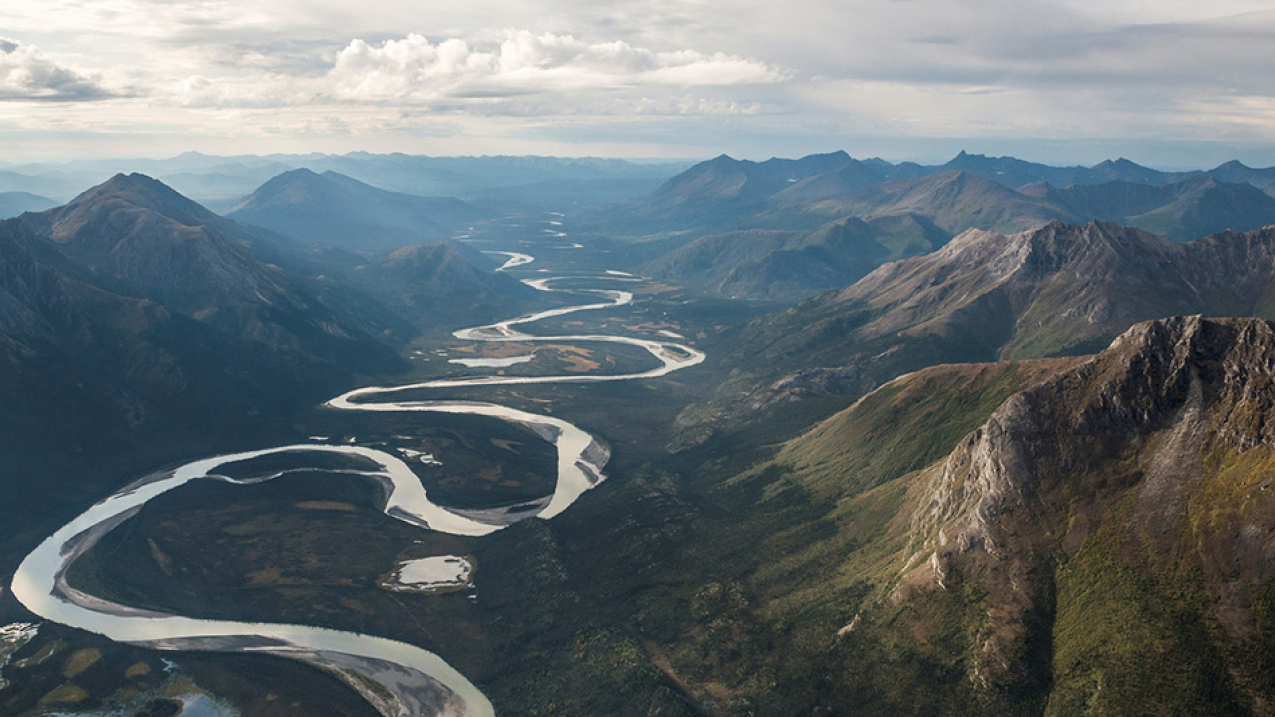
The treeless slopes of the Arctic Divide near the Nunamuit village of Anaktuvuk Pass, Gates of the Arctic National Park and Preserve. Undated photo. (Image credit: Sean Tevebaugh/National Park Service)
The changing Arctic: A greener, warmer and increasingly accessible region
The changing planet, a changing Arctic
Melting ice, warmer weather
Changing marine ecosystems
Navigating uncharted waters
The NOAA Arctic Report Card
Warming at more than twice the rate of anywhere else on Earth, the Arctic is on the front lines of climate change.
The Arctic is warming twice as fast as anywhere else on Earth, which is already affecting the nearly 4 million people living in the region, the fish and wildlife they depend on for food, and their environment. The changes have ramifications far beyond the Arctic to global economies, weather, climate, sea levels, trade and national security.
Sea ice and weather conditions are changing so rapidly in the Arctic that some animals, which have long-evolved to living in extreme cold, now struggle to acclimate to sea ice loss and warming air and water temperatures. Indigenous peoples who rely on marine food sources for sustenance (including 40,000 persons on Alaska’s Arctic coastline) are being challenged to adapt to a new environment.
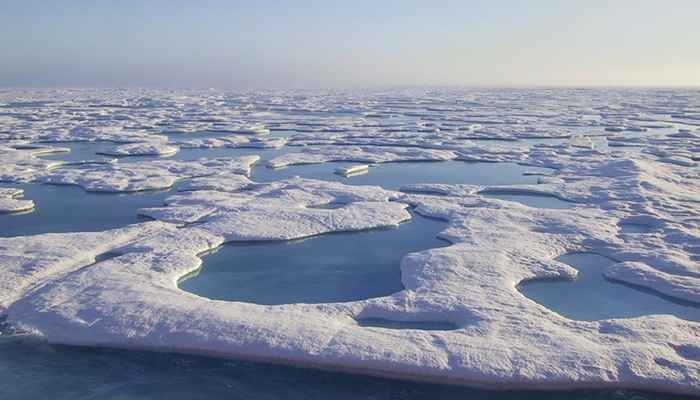
A greener, warmer and increasingly-accessible Arctic opens the region to increased shipping and transportation, research and exploration, and other economic development activities. Any new activities must be conducted with great care. This is a pristine environment, rich with natural resources but one that is remote from emergency services and responders needed during life-threatening emergencies and disasters.
By way of Alaska, the United States is itself an Arctic nation. As such, NOAA has made Arctic science and research a top priority. We take a lead role in collecting and using the environmental information needed to build resilience in this harsh, challenging region. We also engage domestic and international partners to share science, data and observational platforms.
Arctic warming is having profound effects not only on the people of Alaska, but also on communities far from the Arctic.
4 million
The number of people living in the Arctic, including 40,000 in the Alaskan Arctic.
As the Arctic warms, it loses summer sea ice, snow melts sooner in spring and the Greenland Ice Sheet loses mass, which contributes to sea level rise. Unlike snow and ice which reflect 70 percent of the sun’s radiation back to space, the dark colors of open water and snowless land absorb heat and cause the Arctic to warm twice as fast as the rest of the world.
Atmospheric warming is also triggering changes in the jet stream, a major driver of global weather patterns. When the temperature difference between the traditionally cold Arctic air and warmer air of the mid-latitudes breaks down, the jet stream meanders. This phenomenon has been linked to recent severe Arctic cold outbreaks in the winter in the eastern United States and high pressure systems over the western United States that contribute to drought.
Warming is also contributing to rising greenhouse gas emissions from the tundra. Recent research by NOAA and NASA using 41-year measurements from NOAA’s Barrow Observatory show that carbon dioxide emissions from the Arctic have risen 70 percent since 1975.
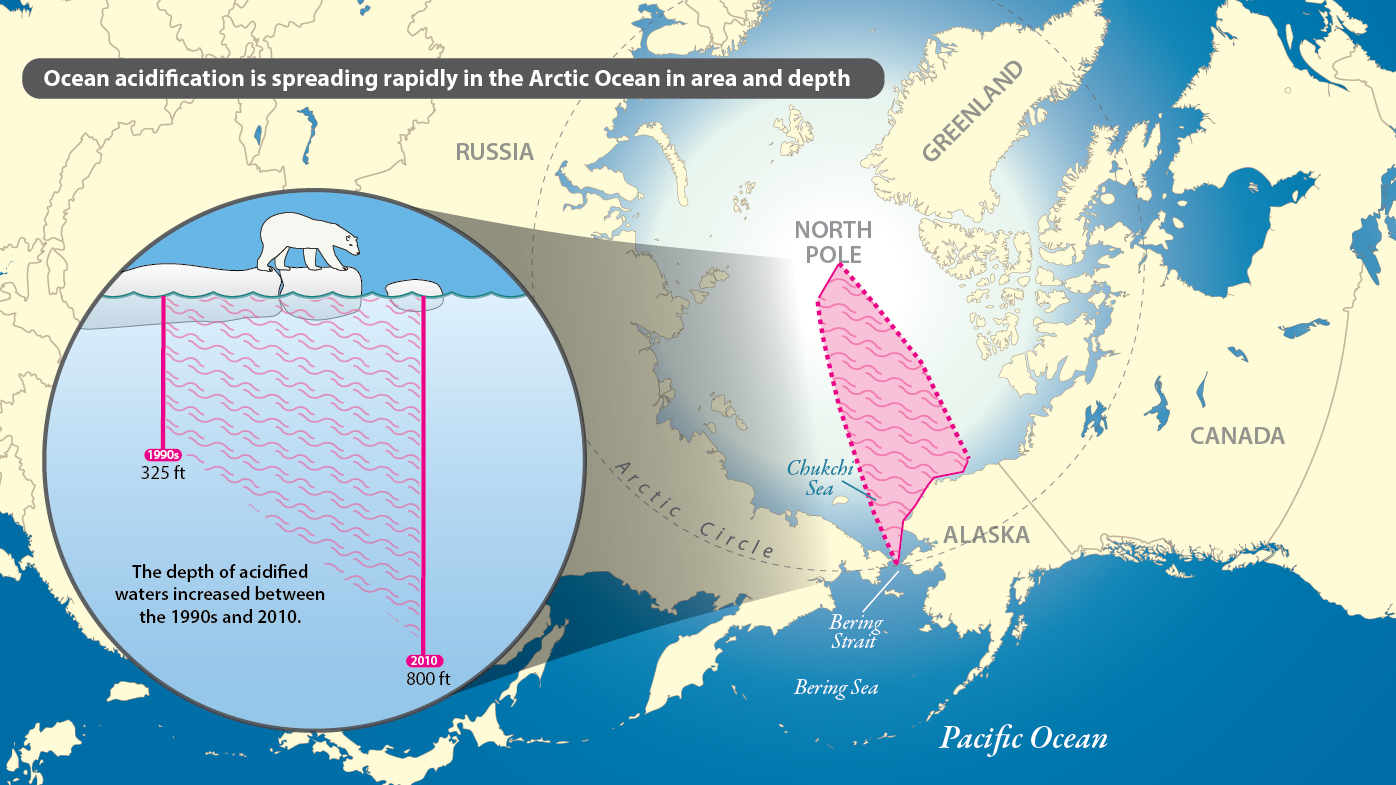
The Arctic Ocean is also becoming more corrosive as it absorbs more atmospheric carbon dioxide, a condition known as ocean acidification. These changes pose significant risk to people and economies of coastal communities; the need for greater monitoring and research in the rapidly changing Arctic that can provide actionable information has never been more urgent.
Warmer temperatures and less sea ice in the Arctic are having profound effects on the region’s ecology: fisheries, marine mammals and wildlife habitats.
When we think of an Arctic in the midst of change, iconic animals like ice seals come to mind. This species uses the sea ice as places for breeding and pupping. Other marine mammals — such as whales, walruses and polar bears — also rely on icy seascapes, are similarly affected to loss of sea ice and are struggling to adapt.
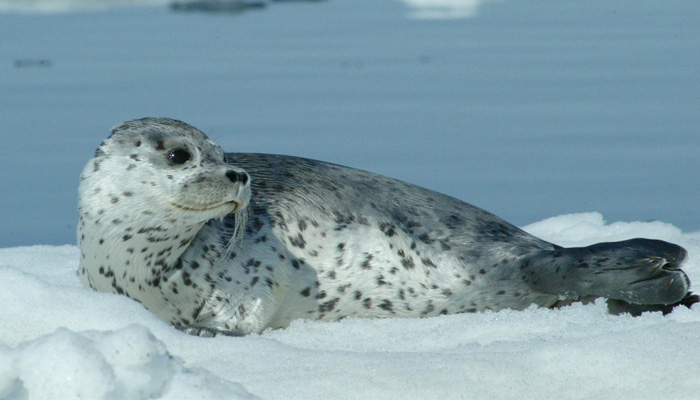
Several wildlife species in the Arctic are listed under the Endangered Species Act, a law that guides the conservation and recovery efforts of NOAA Fisheries and the U.S. Fish and Wildlife Service. NOAA Fisheries specifically is responsible for the following threatened and endangered species with Arctic ranges: bearded seals, ringed seals, bowhead whales and fin whales. Because these animals are key predators, understanding their populations and changes in behaviors reveals vital information on other species and on the dynamics of the Arctic marine ecosystem overall.
NOAA is working to better understand what other natural marine resources exist in this region. In 2009, the U.S. Commerce Department established the Arctic Management Area, a plan that is enabling scientists and research partners to discover what species populate the frigid Arctic waters and in what quantities — from large mammals to tiny phytoplankton and everything in between, including finfish and crab.
As ice melts in the Arctic, more ocean access means more ocean traffic. Mariners need the best available charts and navigation systems to ensure safety on the seas and protection to the environment.
As sea ice continues to disappear, Arctic vessel traffic is on the rise. Recent analyses show we can expect to see a nearly ice-free summer at the top of the world by 2040, if not sooner. This is leading to new maritime concerns, especially in newly emerging areas used by the offshore oil and gas industry, cruise liners, tugs, barges and fishing vessels.
Until recent years, most of the 426,000 square nautical miles of this region were relatively inaccessible by ship due to thick, impenetrable sea ice. NOAA is the nation's chartmaker, and commercial and recreational vessels depend on NOAA nautical charts, data other tools for the latest information on ocean depths, water levels, and shorelines.
Transportation industries rely on NOAA data, tools and response services should oil spills, chemical spills and other accidents occur at sea. Through partnerships, cutting edge technology and extensive data collection, NOAA is prepared and ready to respond to potential incidents. Scientific data and observations also help NOAA and other agencies assess natural resources at risk from pollution, anticipate and track damage assessment, and determine appropriate restoration of the environment after an oil or chemical spill.
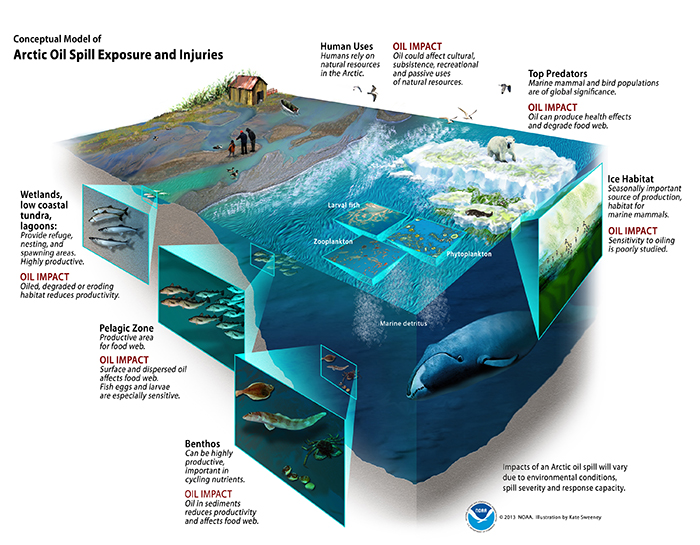
Every year, NOAA scientists join dozens of scientists from around the world to publish findings in the Arctic Report Card.
This NOAA-led, peer-reviewed report provides the latest information on Arctic environmental change, including air and sea surface temperature, sea ice, snow cover, the Greenland ice sheet, vegetation and the abundance of plankton at the base of the marine food chain. It also includes special updates on a variety of emerging issues important to Arctic communities and Arctic science.
The 2017 ARC includes an update on the Eastern Bering Sea groundfish fisheries, the state of permafrost that supports Arctic community infrastructure, and the effects of Arctic warming on wildfire.
According to the 2017 ARC:
-
Average annual air temperature over land areas was the second highest after 2016 in the observational record, with a temperature 2.9 degrees F (1.6 degrees C) above average. Arctic temperatures continue to increase at double the rate of the global temperature increase.
-
The 2017 maximum sea ice extent (coverage), measured each March, was the lowest ever observed, while the 2017 minimum sea ice extent, measured each September, was the eighth lowest on record. The sea ice minimum extent was 1.7 million square miles — 25 percent lower than the average annual minimum sea ice extent for the period from 1981-2010. Arctic ice is thinning, with multiyear ice comprising 21 percent of the ice cover as compared to 79 percent for the more fragile year-old ice. By comparison, multiyear ice made up 45 percent of ice cover in 1985.
-
Average sea surface temperature in August 2017 was 7.2 degrees F (4 degrees C) above the average for 1982-2010 in the Barents and Chukchi seas. The Chukchi Sea showed an ocean surface warming trend from 1982 to 2017 of 1.26 degrees F (0.7 degrees C) per decade.
- Springtime melting and retreating sea ice allowed for more sunlight to reach the upper layers of the ocean, which stimulate widespread blooms of algae and other tiny marine plants that form the base of the marine food chain. It is yet another sign of the rapid changes occurring in a warming Arctic.
The research we conduct, and the data and observations we collect, are cited by other authoritative assessments of Arctic change — specifically scientific studies conducted by the Intergovernmental Panel on Climate Change offsite link and the U.S. Global Change Research Program.
Learn more about NOAA’s scientific programs in the Arctic.
Warming at more than twice the rate of anywhere else on Earth, the Arctic is on the front lines of climate change.
The Arctic is warming twice as fast as anywhere else on Earth, which is already affecting the nearly 4 million people living in the region, the fish and wildlife they depend on for food, and their environment. The changes have ramifications far beyond the Arctic to global economies, weather, climate, sea levels, trade and national security.
Sea ice and weather conditions are changing so rapidly in the Arctic that some animals, which have long-evolved to living in extreme cold, now struggle to acclimate to sea ice loss and warming air and water temperatures. Indigenous peoples who rely on marine food sources for sustenance (including 40,000 persons on Alaska’s Arctic coastline) are being challenged to adapt to a new environment.

A greener, warmer and increasingly-accessible Arctic opens the region to increased shipping and transportation, research and exploration, and other economic development activities. Any new activities must be conducted with great care. This is a pristine environment, rich with natural resources but one that is remote from emergency services and responders needed during life-threatening emergencies and disasters.
By way of Alaska, the United States is itself an Arctic nation. As such, NOAA has made Arctic science and research a top priority. We take a lead role in collecting and using the environmental information needed to build resilience in this harsh, challenging region. We also engage domestic and international partners to share science, data and observational platforms.
Arctic warming is having profound effects not only on the people of Alaska, but also on communities far from the Arctic.
4 million
The number of people living in the Arctic, including 40,000 in the Alaskan Arctic.
As the Arctic warms, it loses summer sea ice, snow melts sooner in spring and the Greenland Ice Sheet loses mass, which contributes to sea level rise. Unlike snow and ice which reflect 70 percent of the sun’s radiation back to space, the dark colors of open water and snowless land absorb heat and cause the Arctic to warm twice as fast as the rest of the world.
Atmospheric warming is also triggering changes in the jet stream, a major driver of global weather patterns. When the temperature difference between the traditionally cold Arctic air and warmer air of the mid-latitudes breaks down, the jet stream meanders. This phenomenon has been linked to recent severe Arctic cold outbreaks in the winter in the eastern United States and high pressure systems over the western United States that contribute to drought.
Warming is also contributing to rising greenhouse gas emissions from the tundra. Recent research by NOAA and NASA using 41-year measurements from NOAA’s Barrow Observatory show that carbon dioxide emissions from the Arctic have risen 70 percent since 1975.

The Arctic Ocean is also becoming more corrosive as it absorbs more atmospheric carbon dioxide, a condition known as ocean acidification. These changes pose significant risk to people and economies of coastal communities; the need for greater monitoring and research in the rapidly changing Arctic that can provide actionable information has never been more urgent.
Warmer temperatures and less sea ice in the Arctic are having profound effects on the region’s ecology: fisheries, marine mammals and wildlife habitats.
When we think of an Arctic in the midst of change, iconic animals like ice seals come to mind. This species uses the sea ice as places for breeding and pupping. Other marine mammals — such as whales, walruses and polar bears — also rely on icy seascapes, are similarly affected to loss of sea ice and are struggling to adapt.

Several wildlife species in the Arctic are listed under the Endangered Species Act, a law that guides the conservation and recovery efforts of NOAA Fisheries and the U.S. Fish and Wildlife Service. NOAA Fisheries specifically is responsible for the following threatened and endangered species with Arctic ranges: bearded seals, ringed seals, bowhead whales and fin whales. Because these animals are key predators, understanding their populations and changes in behaviors reveals vital information on other species and on the dynamics of the Arctic marine ecosystem overall.
NOAA is working to better understand what other natural marine resources exist in this region. In 2009, the U.S. Commerce Department established the Arctic Management Area, a plan that is enabling scientists and research partners to discover what species populate the frigid Arctic waters and in what quantities — from large mammals to tiny phytoplankton and everything in between, including finfish and crab.
As ice melts in the Arctic, more ocean access means more ocean traffic. Mariners need the best available charts and navigation systems to ensure safety on the seas and protection to the environment.
As sea ice continues to disappear, Arctic vessel traffic is on the rise. Recent analyses show we can expect to see a nearly ice-free summer at the top of the world by 2040, if not sooner. This is leading to new maritime concerns, especially in newly emerging areas used by the offshore oil and gas industry, cruise liners, tugs, barges and fishing vessels.
Until recent years, most of the 426,000 square nautical miles of this region were relatively inaccessible by ship due to thick, impenetrable sea ice. NOAA is the nation's chartmaker, and commercial and recreational vessels depend on NOAA nautical charts, data other tools for the latest information on ocean depths, water levels, and shorelines.
Transportation industries rely on NOAA data, tools and response services should oil spills, chemical spills and other accidents occur at sea. Through partnerships, cutting edge technology and extensive data collection, NOAA is prepared and ready to respond to potential incidents. Scientific data and observations also help NOAA and other agencies assess natural resources at risk from pollution, anticipate and track damage assessment, and determine appropriate restoration of the environment after an oil or chemical spill.

Every year, NOAA scientists join dozens of scientists from around the world to publish findings in the Arctic Report Card.
This NOAA-led, peer-reviewed report provides the latest information on Arctic environmental change, including air and sea surface temperature, sea ice, snow cover, the Greenland ice sheet, vegetation and the abundance of plankton at the base of the marine food chain. It also includes special updates on a variety of emerging issues important to Arctic communities and Arctic science.
The 2017 ARC includes an update on the Eastern Bering Sea groundfish fisheries, the state of permafrost that supports Arctic community infrastructure, and the effects of Arctic warming on wildfire.
According to the 2017 ARC:
-
Average annual air temperature over land areas was the second highest after 2016 in the observational record, with a temperature 2.9 degrees F (1.6 degrees C) above average. Arctic temperatures continue to increase at double the rate of the global temperature increase.
-
The 2017 maximum sea ice extent (coverage), measured each March, was the lowest ever observed, while the 2017 minimum sea ice extent, measured each September, was the eighth lowest on record. The sea ice minimum extent was 1.7 million square miles — 25 percent lower than the average annual minimum sea ice extent for the period from 1981-2010. Arctic ice is thinning, with multiyear ice comprising 21 percent of the ice cover as compared to 79 percent for the more fragile year-old ice. By comparison, multiyear ice made up 45 percent of ice cover in 1985.
-
Average sea surface temperature in August 2017 was 7.2 degrees F (4 degrees C) above the average for 1982-2010 in the Barents and Chukchi seas. The Chukchi Sea showed an ocean surface warming trend from 1982 to 2017 of 1.26 degrees F (0.7 degrees C) per decade.
- Springtime melting and retreating sea ice allowed for more sunlight to reach the upper layers of the ocean, which stimulate widespread blooms of algae and other tiny marine plants that form the base of the marine food chain. It is yet another sign of the rapid changes occurring in a warming Arctic.
The research we conduct, and the data and observations we collect, are cited by other authoritative assessments of Arctic change — specifically scientific studies conducted by the Intergovernmental Panel on Climate Change offsite link and the U.S. Global Change Research Program.
Learn more about NOAA’s scientific programs in the Arctic.

